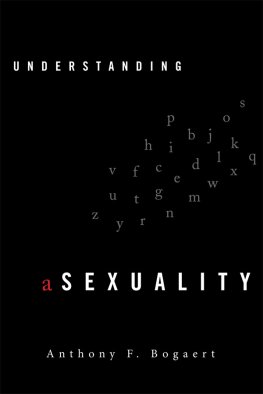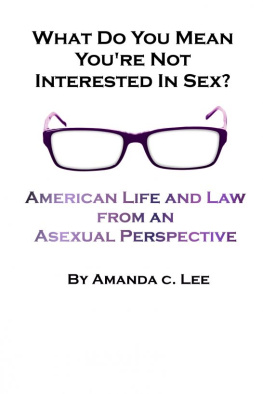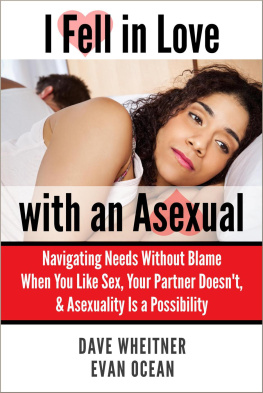Anthony F. Bogaert
UNDERSTANDING ASEXUALITY
A sincere thanks to the following people who helped at various stages of the development of this book: Carolyn Hafer, Sasha Noorgaard, Malvina Skorska, and the editorial staff at Rowman & Littlefield. Your support and generosity are greatly appreciated. I would also like acknowledge the love and support of my mother and father throughout the years; my academic career would not have been possible without them.
I teach and research human sexuality in two academic departmentsthe Department of Community Health Sciences and the Department of Psychologyat Brock University in the Niagara region of Canada. My university is supportive, and I expect that most of my university colleagues respect my work, but a few of my fellow professors are a bit dismissive of what I do. Some joke about what must go on in my human sexuality courses (e.g., Your small-group seminars must be quite the party! or I bet theres a lot of hands-on learning in your courses!). Others tout my courses as the first to deserve a little trimming when university budgets are subject to cutbacks, the suggestion being that sex is taking up too much of the undergraduate curriculum, when, of course, more important and pithy matters could (and should!) supplant it. Still others question the utility of government grants being earmarked for the study of human sexuality.
Why do some of my colleagues treat my research and courses this way? I imagine that they do so, partly, out of a lingering notion that sexual activities, including teaching and research about sexual activities, have to do with the unseemly, the naughty, or at least the unserious side of life. I expect that the seed of this notion is sown very early in the lives of most Westerners (including in these few nonsupportive colleagues), germinates and reaches its peak during adolescence, and then persists in some form into adulthood. In fact, evidence of the persistence of this notion is charming, to a degree, when I witness my (usually male) colleagues revisit the raunchy side of their adolescence and engage in sex banter over a few beers.
I also imagine that these colleagues feel this way because they, like many of their fellow baby boomers, have slipped unawares into their current stage of life: middle age. (By the way, I have also reached this milestone, and have started to label it, somewhat bitterly, as the stage of middle-aged ugly. I call it so because, alas, our beautywhat little we may have had of ithas now faded, and we are saggy and increasingly hairless geeks. Cruel as it may be, fickle Hollywood, with its eyes fixed on beauty, has begun to give us the cold shoulder.) For some of my colleagues, with the best of their youthful charms and vigor behind them, sex is now increasingly off the radar, and a somewhat de-sexualized worldview holds sway. This reflects, of course, a natural transition most adults experience as middle-aged bodies start to change and preoccupations shift to other fancies, including, say, helping ones children negotiate their lives. The famous psychoanalyst, Erik Erikson, aptly summarized this life stage as one preoccupied with generativity: the care of future generations (Stevens, 1983).
But some of my middle-aged colleagues newfound worldview hasyikes!begun to undermine my work, as they have now started to give me looks and behave as if they have had an epiphany on academic values: Why should the study of sex matter so much, when for the vast majority of the moments in our lives, we are not engaged in it, and when the majority of our thoughts and preoccupations are not confined to this rather strange activity, even though, granted, they may have been years ago?
Well, maybe these colleagues are right. Why does sex matter so much? It is true that the vast majority of our lives, even during periods when our lives are extremely sexualized, is not spent engaging in sex. For example, in any given day, much more time is spent eating, watching TV, grooming, or sleeping than having sex. Indeed, sex does not even rate as an identifiable category when activities of the day are tallied (Longley, n.d.). Note that I am assuming a straightforward interpretation of these activities and not one more favorable to a turf-defending sexologist, who might argue that such tallies often do not take into account hidden time devoted to sex, such as viewing sexualized content on TV or other media, or inner-life activities such as sexual fantasizing. But no, lets not quibble. It is true that sexual activities do not take much of the day at all, even if we include hidden sex time. So, what is all the fuss about?
In the 1970s, psychologists became more academically interested in human sexuality. This occurred for a number of reasons, not the least of which was that the sexual world opened up personally and scientifically in the wake of the 1960s sexual revolution. At that time, two publications by two social psychologists, Zick Rubin and Donn Byrne, put forward some convincing arguments that all the fuss about sex was in fact worth it, scientifically speaking (Rubin, 1973; Byrne, 1977). They catalogued a number of reasons for the importance of studying (and teaching about) sexuality. Here are some of their choice examples, along with a few of my own.
Sex is intrinsically interesting to most people, even to those who are not in the reproductive prime of their lives. That my middle-aged colleagues often still turn to the subject of sex after a few beers is evidence that they are still interested in sex, even if their daily lives may contain little behavior that is actually sexual. The prevalence of sexual allusions, if not outright sexual content, in the media also attests to the fact that sex is capable of arousing curiosity in, along with titillating, the young and old alike. In 2010, the most Googled person was not the president of the United States or the pope, but Lady Gaga, the pop music star with a hyper-sexed persona.
The level of scientific curiosity about sex is also high, despite some of my colleagues views. There is a 553-page book (at least in the first edition) called The Female Orgasm (Fisher, 1973), and not even a small pamphlet on the female sneeze. Yet both an orgasm and a sneeze entail similar physiological processes: a buildup of muscular tension released in contorting spasm(s). There must be more intrinsic interest in the former than the latter, even among us (usually) disinterested scientists, to explain the disparity in research. Finally, my courses do not suffer from a paucity of student interesta fact that even my most skeptical colleagues cannot ignore; indeed, sex courses are often the most popular offerings on college campuses.
In short, sex is very interesting to most of us, so why not study and learn about a subject that piques human curiosity? I think this high level of interest/curiosity argument is a convincing one, assuming that all else is equal in terms of sexs scientific importance and health implications relative to other domains of life. But some of you are surely thinking, Aye, theres the rub, because all else is not equal. Sex may pique our curiosity, but it is not on par with other domains of life in its scientific importance or its health implications!
I beg to differ. In terms of scientific importance, sex is on par with, or even trumps, some of the biggest scientific puzzles. Not only do we not fully understand why sex exists (i.e., why some species, for example, reproduce using male and female forms; see chapter 3), but sex is often the clue to unravelling the mystery of a species as a whole, or at least it is never ignored when biologists (e.g., zoologists) study a species as a whole. The same can be said for the study of humans. To understand our sexuality is to understand ourselves. There is an ancient Chinese proverb that says, To understand the head, one must begin by studying the tail. (Using an animal metaphor to make its point, this proverb is, of course, meant to reveal the secret to understanding human beings.) Sigmund Freud, the famous psychoanalyst, and evolutionary psychologists (strange bedfellows, indeed!) have thought similarly, suggesting that sex is the major scientific puzzle of human nature, and that to understand sex is to understand human beings. So, the









